Plantations were integral to the development of the original 13 American colonies, contributing significantly to their economies and shaping the course of American history. These large agricultural estates were responsible for the cultivation of cash crops and played a pivotal role in colonial life. Listed below are a few notable plantations in the original 13 colonies, their locations, owners, and the economic impact they had on colonial America.
Mount Vernon Plantation, 1735
Location: Mount Vernon, Virginia (Northern Neck region).
Owner: George Washington.
Economic Impact: Mount Vernon was one of the most famous plantations in the American colonies, and it was primarily known for its cultivation of tobacco. George Washington, the plantation owner, implemented innovative farming practices that contributed to the prosperity of the estate. While tobacco was the dominant crop, Washington also diversified his agricultural pursuits by growing wheat and other crops, improving soil quality, and increasing productivity. The economic success of Mount Vernon enabled Washington to play a leading role in the American Revolution and ultimately become the first President of the United States.
Middleton Place Plantation, 1738
Location: Charleston, South Carolina.
Owner: Arthur Middleton.
Economic Impact: Middleton Place was a prominent rice plantation in South Carolina, known for its complex irrigation systems. Rice was a highly profitable cash crop, and the labor-intensive cultivation and processing of rice required expertise in hydraulic engineering, making plantations like Middleton Place economic powerhouses. The success of rice plantations significantly contributed to the wealth and prosperity of the South Carolina low country.
Stratford Hall Plantation, 1725
Location: Westmoreland County, Virginia (Northern Neck region).
Owner: The Lee Family (Robert E. Lee’s Ancestral Home).
Economic Impact: Stratford Hall, the ancestral home of the Lee family, was primarily a tobacco plantation during the colonial period. Tobacco was a cash crop that drove the colonial economy, and Stratford Hall was no exception. The plantation’s wealth and economic influence made it a prominent estate in Virginia.
Boone Hall Plantation, 1681
Location: Mount Pleasant, South Carolina.
Owner: Various Owners.
Economic Impact: Boone Hall Plantation, known for its picturesque “Avenue of Oaks,” was involved in the production of cotton, pecans, and strawberries. While the plantation changed hands several times over its history, its agricultural pursuits contributed to the regional economy. Cotton, in particular, became a major cash crop in the South during the 19th century, with profound economic implications for the entire nation.
Shirley Plantation, 1613
Location: Charles City County, Virginia (James River region).
Owner: Hill Carter.
Economic Impact: Shirley Plantation is one of the oldest plantations in Virginia, known for its Georgian architecture and historic significance. Like many other Virginia plantations, Shirley was dedicated to tobacco cultivation. Tobacco was the economic lifeblood of the region during the colonial period, driving trade and prosperity.
Monticello Plantation, 1768
Location: Charlottesville, Virginia (Piedmont region).
Owner: Thomas Jefferson.
Monticello was the plantation estate of Thomas Jefferson, the third President of the United States. Jefferson was an innovative farmer and cultivated various crops, including tobacco, wheat, vegetables, and experimental plants.
Plantations in the original 13 colonies were not only agricultural enterprises but also economic engines that contributed significantly to the development of colonial America. These plantations played a critical role in the production of cash crops, such as tobacco, rice, and cotton, which fueled the colonial economy. They were owned by prominent individuals whose wealth and influence extended beyond their estates, shaping the course of American history. Recognizing the economic impact of these plantations is essential for understanding the economic and social dynamics that characterized colonial America.
MORE:

